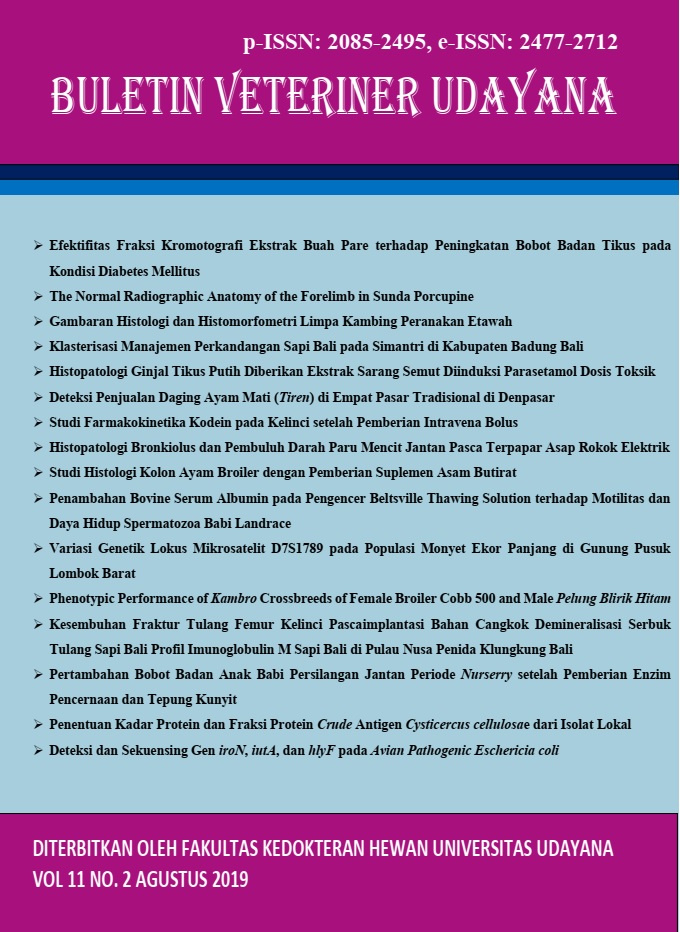GENETIC VARIATION OF D7S1789 MICROSATELLITE LOCUS IN LONG-TAILED MACAQUES AT MOUNT PUSUK WEST LOMBOK
Abstract
Long-tailed macaques (Macaca fascicularis) are Southeast Asian endemic animal with its behaviors and interactions form a protective cohesive group on its territory. Such patterns create distinctions that can be detected by microsatellite variations. This study revealed polymorphism of the D7S1789 microsatellite locus in a population of long-tailed macaques in Mount Pusuk West Lombok with the aim of knowing the genetic variation in the form of number of alleles, allele frequencies, heterozygosity and Hardy-Weinberg Equilibrium based on its allele’s distributing the Chi-square test. A total of 17 blood samples of long tailed macaque extracted used QIAamp DNA blood kit from QIAGEN to get DNA, DNA from locus D7S1789 microsatellite was replicated through 30 cycles of PCR technique, with annealing temperature 57°C. The alleles were raised by silver staining using 8% polyacrylamide gel. The results obtained two alleles with a frequency of 121 bp (0.794) and 130 bp (0.206), heterozygosity (0.337) and Hardy-Weinberg Equilibrium test (?2 count) was 0.422 (?2 table = 3.841; ? = 0.05; db = 1) which indicates a random mating population. It can be concluded that the D7S1789 microsatellite locus was polymorphic in the population of long-tailed monkeys in Mount Pusuk, West Lombok.
Downloads
References
Allendorf FW, Luikart G, Aitken SN. 2013. Conservation and the genetics of populations. 2nd Ed. United Kingdom, Willey and Blackwell.
Arisuryanti T, Daryono BS. 2007. Genetika populasi. Yogyakarta, Fakultas Biologi Universitas Gadjah Mada.
Balloux F, Lugon-Moulin N. 2002. The estimation of population differentation with microsatellite markers. Mol. Ecol. 11: 155-165.
De Ruiter JR, Geffen E. 1998. Relatedness of matrillines, dispersing and social groups in long tail macaques (Macaca fascicularis). Proc. R. Soc. Lond. 265:79-87.
Dewi EK, Soma IG, Wandia IN. 2013. Diversitas genetik populasi monyet ekor panjang menggunakan marka molekul mikrosatelit D3S1768. Indon. Med. Vet. 2(1): 43-57.
Dwiwandana B, Suatha IK, Wandia IN. 2013. Karakteristik lokus mikrosatelit D7S1789 pada populasi monyet ekor panjang (Macaca fascicularis) di Wanara Wana, Padang Tegal, Ubud, Bali. Indon. Med. Vet. 2(4): 375-384.
Eudey AA. 1994. Temple and pet primates in Thailand. Rev. Ecol. 49: 273-280.
Fooden J. 2006. Comparative review of fascicularis-group species of macaques (Primates: Macaca). Fieldiana Zool. 107: 1-43.
Frankham R, Ballou JD, Briscoe DA. 2004. A primer of conservation genetics. Cambridge, Cambridge University Press.
Gemayel R, Vinces MD, Legendre M, Verstrepen KJ. 2010. Variable tandem repeats accelerate evolution of coding regulatory sequences. Ann. Rev. Gen. 44: 445-477.
Hillis DM, Moritz C, Mable BK. 1996. Molecular systematics. 2nd Ed. Sunderland MA: Sinauer Associates, Inc.
Karimullah, Anuar S. 2011. Social organization and mating system of Macaca fascicularis (long tailed macaques). Int. J. Biol. 3(2): 23-31.
Krawscjack M. Schmidtke J. 1994. DNA fingerprint. Oxford, BIOS Scientific Publisher Ltd.
Lang KC, Crockett C. 2006. Long tailed macacaque-Macaca fascicularis. Primate Info Net Library and Information cervice National Primate Research Center, University of Wisconsin – Madison. http://pin.primate.wisc.edu/factsheets/entry/long-tailed_macaque (diakses tanggal 10 Februari 2017).
Maharani D, Soma IG, Wandia IN. 2014. Karakteristik lokus mikrosatelit D10S1432 pada populasi monyet ekor panjang di Taman Nasional Alas Purwo Banyuwangi. Indon. Med. Vet. 3(3): 244-251.
Monica WS, Widyastuti SK, Wandia IN. 2012. Keragaman populasi monyet ekor panjang di Pura Pulaki menggunakan marka molekul mikrosatelit D13S765. Indon. Med. Vet. 1(1): 37-54.
Nei M. 1987. Molecular evolutionary genetics. New York, Colombia University Press.
Suartha IN, Putra IGAA, Wandia IN. 2002. Pembiusan monyet ekor panjang (Macaca fascicularis) jantan dengan campuran Ketamin dan Xylazin pada topografi daerah berbeda. J. Vet. 4(1): 15-20.
Wandia IN. 2001. Variasi genetik monyet ekor panjang (Macaca fascicularis) di beberapa lokasi di Bali. Thesis. Institut Pertanian Bogor, Indonesia.
Wienberg J, Stanyon R. 1998. Comparative chromosome painting of primate genomes. ILAR J. 39(2-3): 77-79.





